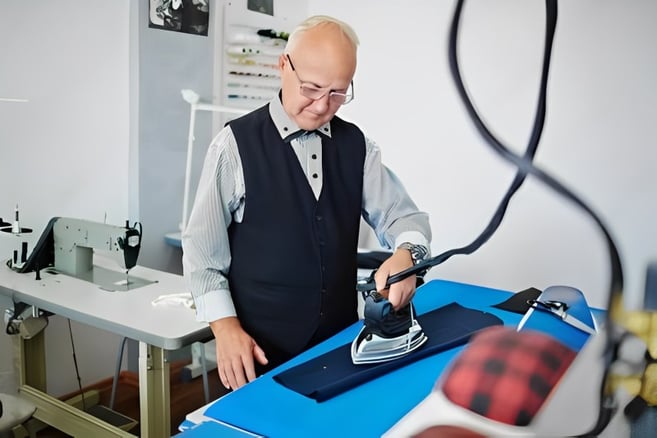Pressing Perfection: The Importance of Irons and Pressing Tools
Unveil the art of pressing perfection in our latest blog post: 'Pressing Perfection – The Importance of Irons and Pressing Tools.' Discover the key to flawless sewing as we delve into the significance of quality irons and pressing tools for achieving professional-looking garments
BEGINNERS GUIDE
12/10/20233 min read


The Art of Pressing: Elevating Your Garments to Perfection
When it comes to achieving professional-looking garments, one often overlooked but crucial step is the art of pressing. While sewing and construction techniques are essential, it is the pressing process that truly elevates a garment to perfection. In this article, we will explore the role of irons and pressing tools in achieving flawless results, discuss different iron types, and delve into various pressing techniques for different fabrics.
The Role of Irons and Pressing Tools
Irons and pressing tools play a vital role in the garment-making process. They help to shape, smooth, and set fabric, ensuring that seams lie flat, hems are crisp, and pleats are well-defined. By applying heat and pressure, these tools transform a garment from something that appears homemade to a professional-looking piece.
While a sewing machine is the primary tool for constructing garments, an iron is equally important for achieving a polished finish. It is the magic wand that brings life to the fabric, making it appear as though it was crafted by an expert.
Different Iron Types
Not all irons are created equal. There are several types available, each with its own unique features and benefits. Let's explore some of the most common iron types:
Conventional Irons: These are the traditional irons that most of us are familiar with. They are versatile and suitable for a wide range of fabrics. Conventional irons often come with adjustable temperature settings, allowing you to tailor the heat to the specific fabric you are working with.
Steam Irons: Steam irons are equipped with a water reservoir that produces steam. The steam helps to relax and remove wrinkles from the fabric, making it easier to press. Steam irons are particularly useful for fabrics that are prone to wrinkling, such as cotton or linen.
Pressing Tools: In addition to conventional and steam irons, there are specialized pressing tools available. These tools are designed to target specific areas of a garment, such as seams, darts, or collars. Some examples include tailor's hams, sleeve rolls, and clapper boards. These tools provide a more precise and effective way to press hard-to-reach areas, resulting in a professional finish.
Pressing Techniques for Different Fabrics
Each fabric has its own unique characteristics and requires a specific pressing technique to achieve the best results. Let's explore some common fabric types and the corresponding pressing techniques:
Cotton: Cotton is a popular fabric choice for many garments. To press cotton, start by setting your iron to the appropriate temperature for cotton fabrics. Use steam to remove any wrinkles, and press with firm, even pressure. Pay special attention to seams and hems to ensure they lie flat.
Wool: Wool is a delicate fabric that requires extra care when pressing. Use a pressing cloth to protect the fabric and set your iron to a low or medium heat setting. Press with a gentle touch, avoiding heavy pressure that could flatten the texture of the wool. Steam can be used sparingly, if necessary.
Silk: Silk is a luxurious fabric that requires a delicate touch. Set your iron to a low heat setting and use a pressing cloth to protect the fabric. Press lightly and quickly, avoiding prolonged contact with the iron to prevent scorching or damaging the silk fibers.
Denim: Denim is a sturdy fabric that can withstand higher heat and pressure. Set your iron to a high heat setting and use steam to remove wrinkles. Press firmly, paying extra attention to seams and hems to achieve a crisp, professional finish.
Mastering the Art of Pressing
While the choice of iron and fabric-specific pressing techniques are important, mastering the art of pressing also requires practice and attention to detail. Here are some tips to help you achieve pressing perfection:
Always press on a clean, flat surface. A padded ironing board or a pressing mat will provide the best results.
Use a pressing cloth or a piece of muslin to protect delicate fabrics from direct contact with the iron.
Take your time and press each area of the garment systematically, ensuring that all wrinkles and creases are eliminated.
Pay attention to the grainline of the fabric and press accordingly to maintain the garment's shape and drape.
Allow the fabric to cool and set before moving on to the next section. This will help the fabric retain its shape and prevent wrinkles from reappearing.
Conclusion
In the world of garment-making, the importance of irons and pressing tools cannot be overstated. These tools are the secret to achieving professional-looking results, transforming homemade garments into works of art. By understanding the different iron types, mastering fabric-specific pressing techniques, and paying attention to detail, you can elevate your sewing projects to new heights of perfection. So, embrace the art of pressing and watch as your garments come to life with a flawless finish.